Von Steuben I (Id. No. 3017)
1917-1919
Friedrich Wilhelm Ludolf Gerhard Augustin von Steuben -- born 17 September 1730 in Magdeburg in the Electorate of Brandenburg [Germany] – was the son of a lieutenant of engineers in the army of Frederick William I, King of Prussia and Elector of Brandenburg. He spent his early childhood in Russia where his father had entered the service of Tsarina Anne at the command of Frederick William I. After the accession of Frederick [the Great] II to the Prussian throne, von Steuben returned to Germany with his father in 1740.
In 1747, at age 17, he became a cadet in a Prussian infantry regiment and, two years later, received his patent (commission) as an ensign. Von Steuben served with distinction during the Seven Years’ War. His specific training and experience in general staff duties equipped him for his later role in the American Revolution.
Von Steuben was discharged from the Prussian Army when Frederick down-sized the force after the Seven Years’ War in 1763. Having found employment elsewhere, he was dismissed from that service and the subsequent financial difficulties caused him to go to Paris in June 1777 to seek a position with either the French Army or the Continental Army. Benjamin Franklin provided Steuben with letters of introduction to General George Washington and Robert Morris with the understanding that he would be a volunteer without rank or pay. He sailed from Marseilles, France in September and arrived at Portsmouth, N.H. on 1 December.
Von Steuben reported to George Washington at Valley Forge, Pa., in late February 1778. In March, Washington asked von Steuben to serve temporarily as inspector general. In short order, he was successful in the training the Continental Army to the exacting standards of the Prussian Army. Thereafter, the Army proved itself, battalion for battalion, the equal in discipline of the best British regulars. He also drafted the Regulations for the Order and Discipline of the Troops of the United States which remained in active use by American troops into the War of 1812. In 1780 he sat on the court-martial of Major John André, the captured British Army officer, charged with espionage in conjunction with the defection of General Benedict Arnold. Later, von Steuben served with distinction with General Nathanael Greene in the Carolinas in 1780-81 and with General Lafayette at Yorktown in 1781. After the British surrender at Yorktown, he continued to serve as the Continental Army’s Inspector General.
Von Steuben joined General Henry Knox (later the first Secretary of War) at Vail's Gate, near West Point, N.Y. in the fall of 1782 and in early 1783 moved to the Verplanck homestead, at Mount Gulian, across the Hudson River from Washington's headquarters in Newburgh, N.Y. Steuben provided assistance to Washington in demobilizing the army in 1783, as well as aiding in the defense plan of the new nation. In May 1783, Steuben presided over the founding of the Society of the Cincinnati. He resigned his commission and was discharged from the Army with honor on 24 March 1784.
Von Steuben became a U.S. citizen by act of the Pennsylvania Legislature in March 1784 (and later by the New York authorities in July 1786). With the war over, he resigned from the Army and first settled in New York City, where he became a prominent figure and elder in the German Reformed Church. In 1790 Congress awarded him a pension of $2,500 a year, which he kept until his death.
Von Steuben moved to upstate New York and settled in Oneida County on a small estate in the vicinity of Rome, on land granted to him for his military service and where he had spent summers in a log cabin between 1790 and 1794. He was later appointed a regent for what evolved into the State University of New York.
Von Steuben died on 28 November 28 at his estate and was buried in a grove at what became the Steuben Memorial State Historic Site; the estate became part of the town of Steuben, N.Y., which was named for him.
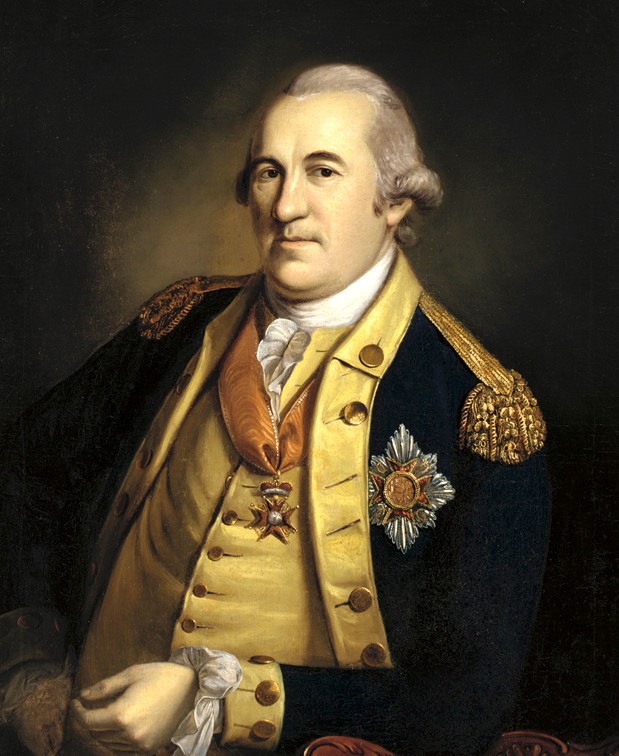
I
(Id. No. 3017: displacement 23,500; 1ength 663'0"; beam 66'0"; draft 30'0"; speed 23 knots; complement 975; armament 8 5-inch, 4 3-inch, 2 3-inch, 4 1-pounders, 8 machine guns)
The twin-screw, steam passenger ship Kronprinz Wilhelm, constructed in 1901 at Stettin, Germany, by the Aktiengesellschaft Vulcan, served the transatlantic passenger liner fleet of the Norddeutscher Lloyd Line for thirteen years carrying passengers between North America and the North Sea ports of Europe. When the World War broke out on 1 August 1914, the liner lay in port at New York City. Two days later, she sailed on orders from the German Admiralty and headed south to rendezvous with the cruiser SMS Karlsruhe. After a three-day voyage, she met the cruiser just to the north and west of the Bahama Islands. In just over two hours, Karlsruhe transferred two 8.8 cm. rapid fire guns, 290 rounds of 8.8 cm. ammunition, a machine gun, and 36 rifles as well as one officer, two non-commissioned officers, and 13 ratings. Just before the approach of HMS Suffolk abbreviated the rendezvous, Kronprinz Wilhelm was commissioned an auxiliary cruiser in the Imperial German Navy, Kapitänleutnant Thierfelder, formerly Karlsruhe's navigation officer, in command.
The proximity of the British cruiser forced the two German warships to cast off hastily and speed away in different directions. Kronprinz Wilhelm headed north for a time, then steered west and southwest, and she finally steadied up on a course generally east toward the Azores. She reached her destination on 17 August 1914 and rendezvoused with the German steamer Walhalla off St. Miguel Island. During the following four days, she coaled from Walhalla during the days; and the two ships steamed on a southerly course during the nights. After completing the coaling and provisioning operation, the newly commissioned commerce raider learned from German representatives at Las Palmas in the Canary Islands that no further coal would be available in the neighborhood of the Azores and the Canaries. Consequently, her commanding officer decided to head for the Brazilian coast where he hoped to find sources of coal more friendly to Germany or at least a greater choice of neutral ports in which to intern his ship if she should find herself unable to replenish her supplies from captured ships.
During the voyage to the Azores and thence to the South American coast, Kronprinz Wilhelm had to avoid contact with all shipping since she was not ready to embark upon her mission raiding Allied commerce. The guns had to be emplaced and a target for gunnery practice constructed. The crew, mostly reservists and civilians, received a crash course in their duties in a warship and in general naval discipline. A prize crew was selected and trained in the techniques of boarding prizes, inspecting cargo and ship's papers, and in using explosive charges to sink captured ships. Finally, all members of the crew were outfitted in some semblance of a naval uniform.
The crew worked at a feverish pace to be ready, and by the time Kronprinz Wilhelm met Karlsruhe’s tender Asuncion near Rocas Reef north of Cape San Roque on 3 September 1914, preparations were nearly complete – it proved none too soon, for at 8:30 the following evening, the auxiliary cruiser encountered the British steamer Indian Prince. The merchantman stopped without the raider's firing a shot. Heavy seas, however, postponed the boarding until shortly after 6:00 the following morning. The prize crew found a cargo composed largely of contraband; but, before sinking the ship, Thierfelder wanted to salvage as much of her supplies and fuel as he could, principally the latter. Continued heavy seas precluded the transfer until the afternoon of 8 September. Indian Prince's crew and passengers were brought over to Kronprinz Wilhelm at around 1400, and the two ships moved alongside each other immediately thereafter. Coaling started and continued throughout the night of 8 and 9 September. The following morning, the German prize crew detonated three explosive charges which sank Indian Prince. Kronprinz Wilhelm then headed south to rendezvous with several German supply ships.
Coal, more than any other factor, proved to be the key to the success of Kronprinz Wilhelm's cruise. The hope of finding that commodity had brought her to the coast of South America, and her success in locating sources of it kept her there. Initially, she replenished from German steamers sent out of South American ports specifically for that purpose. In fact, she spent the next month coaling from four such auxiliaries before she even contacted her next victim. That event occurred on 7 October 1914, when she hailed the British steamer La Correntina well off the Brazilian coast in about the same latitude as Rio de Janeiro. The next day, the raider went alongside the captured ship to seize the prize's coal and cargo of frozen meat before sinking her. During the operation, she also improved her martial appearance, though not her actual military capability, when she took La Correntina's two ammunition-less 12 cm. guns and their splinter shields. Later, the raider mounted the additional guns aft and they were used for gun drills and to fire warning shots with modified, blank salute cartridges. She continued coaling and provisioning operations from La Correntina until 11 October when bad weather forced a postponement. On the 14th, she resumed the transfer of fuel but broke off again when she intercepted a wireless message indicating that her captive's sister ship La Rosarina had departed Montevideo two days earlier and would soon pass nearby. The prize crew placed the usual three explosive charges, and La Correntina sank that same day.
During the ensuing five months, Kronprinz Wilhelm cruised the waters off the coast of Brazil and Argentina. Her success in finding ships laden with coal and supplies combined with her luck and skill in evading British cruisers enabled the raider to capture 15 ships. Of that number, she sank 13 for sure; another she damaged severely by ramming, and it probably sank later. The remaining ship served as transportation into port for what had become an unbearable number of detainees on board after her 12th capture.
Late in March 1915, the auxiliary cruiser headed north to rendezvous with another German supply ship at the equator. She arrived at the meeting point on the morning of the 28th and cruised in the neighborhood all day. That evening, she sighted a steamer in company with two warships, undoubtedly British, 20 miles distant. Though Kronprinz Wilhelm did not know it at the time, she had just witnessed the capture of Macedonia, her supply ship, by two British cruisers. The raider steamed around in the general vicinity for several days, but the passage of each succeeding day further diminished her prospects of a successful rendezvous. Finally, a dwindling coal supply and an alarming increase in the sick list forced Kronprinz Wilhelm to make for the nearest neutral port. Early in the morning of 11 April, she stopped off Cape Henry, Va., and took on a pilot. At 10:12 a.m., she dropped anchor off Newport News, Va., and ended her 72-day cruise during which she steamed 37,666 miles and destroyed just under 56,000 tons of Allied shipping. As she did not depart within the time prescribed by international law, Kronprinz Wilhelm was interned and moved to the Norfolk Navy Yard, Portsmouth, Va., on 4 May 1915.
Though interned, Kronprinz Wilhelm had not quite ended her wartime career. After she interned herself, Kronprinz Wilhelm was moved to the Philadelphia (Pa.) Navy Yard where she arrived on 29 September 1916. On 6 April 1917, the U.S. declared war upon the German Empire. That same day, the Collector of Customs for the Port of Philadelphia seized the former German raider in the name of the United States. The work of repairing her and refitting her as an auxiliary cruiser began on 15 April. On 22 May, President Wilson issued the executive order which empowered the Navy to take possession of the ship. On 9 June 1917, Kronprinz Wilhelm was renamed Von Steuben, and, having been given the identification number (Id. No.) 3017, was commissioned at Philadelphia, Lt. Charles H. Bullock in command.
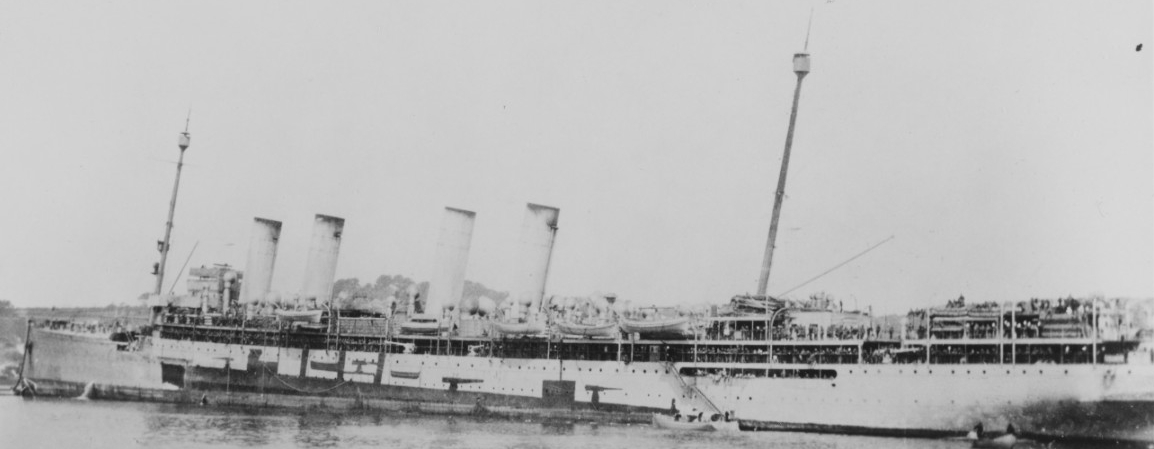
Von Steuben began her Navy career as an auxiliary cruiser. Through the summer of 1917, her crew and workers at the Philadelphia Navy Yard prepared her to resume that role against her former masters. On 21 September, however, the Office of the Chief of Naval Operations (OpNav) dispatched a telegram to Commandant, Philadelphia Navy Yard, stating “Upon completion repairs…Department proposes assigning her to transport duty for limited period. You are directed to provide necessary fittings and equipment before present date completion to fit her for duty proposed.” The ship completed preparations by 29 September and put to sea the next day for trials. She arrived at Hampton Roads, Va. on 2 October. She coaled there (3-5 October) then stood out at 12:15 p.m. on 6 October bound for a return to Philadelphia. She arrived at the Navy Yards at 6:10 p.m. on the 7th. The next day a fire was discovered in the coal bunker and quickly extinguished. She held deck trials on 12 October and was underway again on 14 October for post repair trials. She returned to Philadelphia on 17 October. A week later, on 24 October, she collided with the Japanese steamer Yokohama Maru at the Philadelphia Navy Yard. What little damage that did occur was quickly repaired. On 25 October, she stood down the Delaware River en route to New York with aviation, medical officers, nurses, and other officers for passage to Europe. She anchored off Tompkinsville [Staten Island], N.Y. on the 26th and remained there at anchor until she received details for transport to Europe.
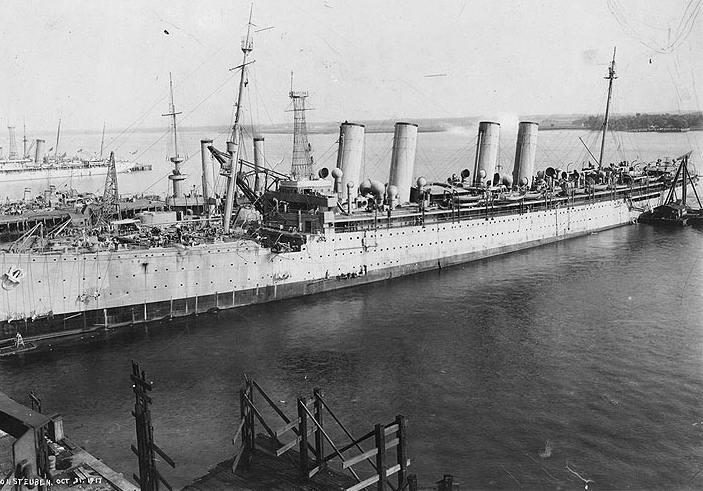
Von Steuben stood out of New York on 31 October 1917, for her first transatlantic voyage under the American flag with the 3rd Battalion, Sixth Regiment of Marines (1,223 troops and passengers) bound for Brest, France (Base No. 7). A unit in Group No. 10, she was escorted by the flagship North Carolina (Armored Cruiser No. 12) and accompanied by fellow transports, Mount Vernon (Id. No. 4508), Agamemnon (Id. No. 3004), and American (later Id. No. 2292).
Around 6:05 a.m. on 9 November, Von Steuben received some damage when another troop ship, Agamemnon, formerly Kaiser Wilhelm II, collided with her during a zigzag maneuver. Both ships lost men overboard, and a few received injuries. In addition, two of her 5-inch/51 guns and one of her 3-inch guns were damaged. Though her bow was opened to the sea, Von Steuben maintained 12 knots while the damage control party made repairs.
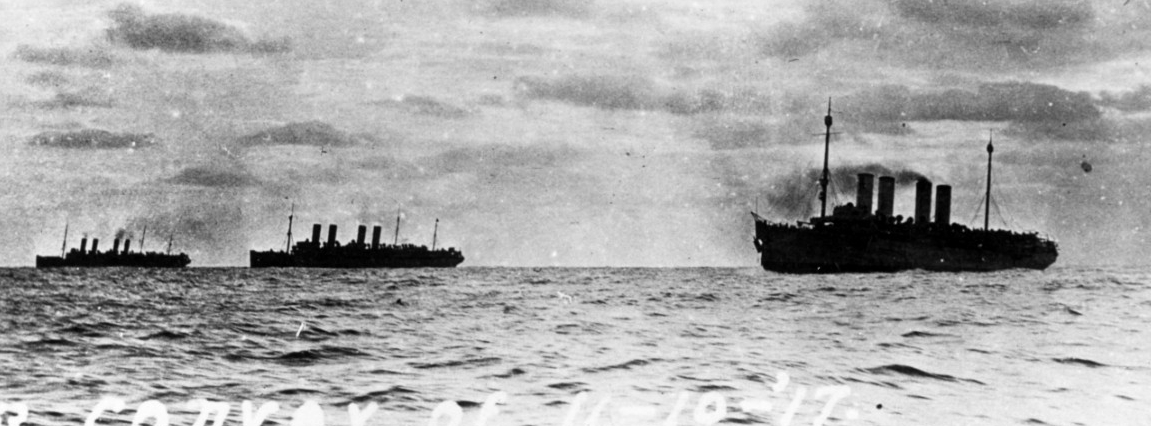
Von Steuben continued on with the convoy and arrived in Brest on 12 November 1917. She disembarked passengers and unloaded cargo between 14 and 19 November; but she did not depart until the 28th. On her return to the United States, Von Steuben had to stop over at Halifax, Nova Scotia. Around 9:14 a.m. on 6 December, she was about 40 miles from Halifax when lookouts spied a great flame and a high column of smoke in the direction of the port. Visual contact was followed rapidly by the concussion from the explosion of the French ammunition ship Mont Blanc, which had caught fire after colliding with the Norwegian vessel Imo in Halifax harbor. Von Steuben learned the facts when she entered the harbor around 2:30 p.m. A portion of the city had been devastated by the explosion and the fire which followed. She responded to the emergency by landing a relief party of 260 men under the command of Lt. Fred T. Berry to patrol the city and assist in rescue efforts. They were joined in this effort by a landing party from Tacoma (Cruiser No. 18). The transport remained at Halifax until 10 December and then continued her voyage back to Philadelphia where she arrived on the 13th and disembarked her passengers and started loading Marine Corps stores.
Von Steuben got underway from Philadelphia again on 15 December. She coaled at Newport News on the 16th and remained there until the 20th when she returned to sea, bound for Guantanamo Bay, Cuba, where she disembarked marines from the 9th Regiment with their equipment (24-25 December). On 27 December, she got underway for the Panama Canal Zone. The ship transited the canal to the Pacific side on 29 December and entered the dry dock at Balboa the following day. Over the next three weeks, she received repairs of the damage to her bow. On 20 January 1918, the ship floated out of the dock and then retransited the canal. After coaling at Colon, she departed the Canal Zone and headed back to the east coast. Von Steuben stopped at Newport News (26-31 January) where she took on two new 5-inch guns and a 3-inch gun to replace those damaged in the collision with Agamemnon. On 1 February, she returned to Philadelphia to embark marines and load cargo in order to resume her duty transporting troops to France.
Von Steuben, with 1,181 marines of the 1st Replacement Battalion embarked, stood down the Delaware River to join another convoy on 6 February 1918. She arrived at Tompkinsville the next day and rendezvoused with the convoy. Escorted by Pueblo (Armored Cruiser No. 7), the transports, Von Steuben, Finland (Id. No. 4543), Martha Washington (Id. No. 3019), President Lincoln, and Antigone (Id. No. 3007) departed as Group No. 20 bound for Brest. The convoy reached its destination, Brest, without incident on the 24th. Von Steuben unloaded her troops and cargo the next day. On 26 February, she embarked passengers for return to the U.S. At 4:29 p.m. on 1 March, she stood out from Brest to make her return to the U.S. in company with Antigone, Martha Washington, and Tiger (Id. No. 1640) and escorted by Roe (Destroyer No. 24) and Monaghan (Destroyer No. 32).
While en route, at 4:20 p.m. on 5 March 1918, a lookout spotted an object to port which resembled a submarine periscope. The alarm brought gun crews to their action stations, and they opened fire immediately. Before anyone realized that they were firing upon innocuous flotsam, a tragic accident occurred. A shell from one of her 5-inch/51 guns exploded immediately upon leaving the barrel, and fragments struck three sailors. One died instantly, and the other two succumbed to their wounds later that night. The incident prompted the convening of a board of investigation and boards of inquest.
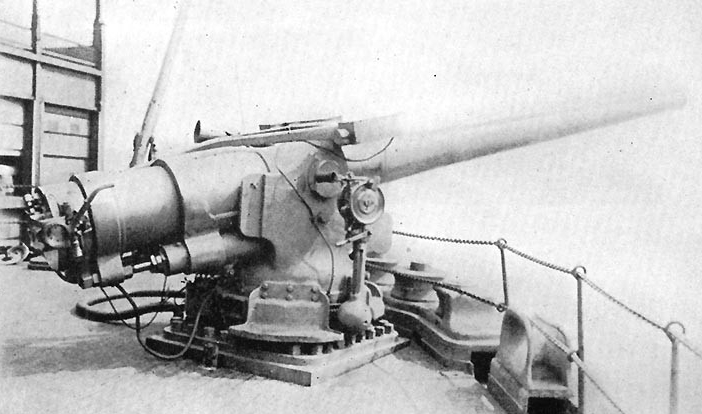
Von Steuben coaled at Bermuda (12-13 March 1918) and arrived at Norfolk Navy Yard, Newport News, Va., on the 16th. She then underwent previously authorized alterations and coaled at Newport News (17-19 March). Afterward, she got underway on 21 March. Bound for Philadelphia, she arrived on 23 March and embarked Army troops and sailors and loaded cargo for her third voyage to France.
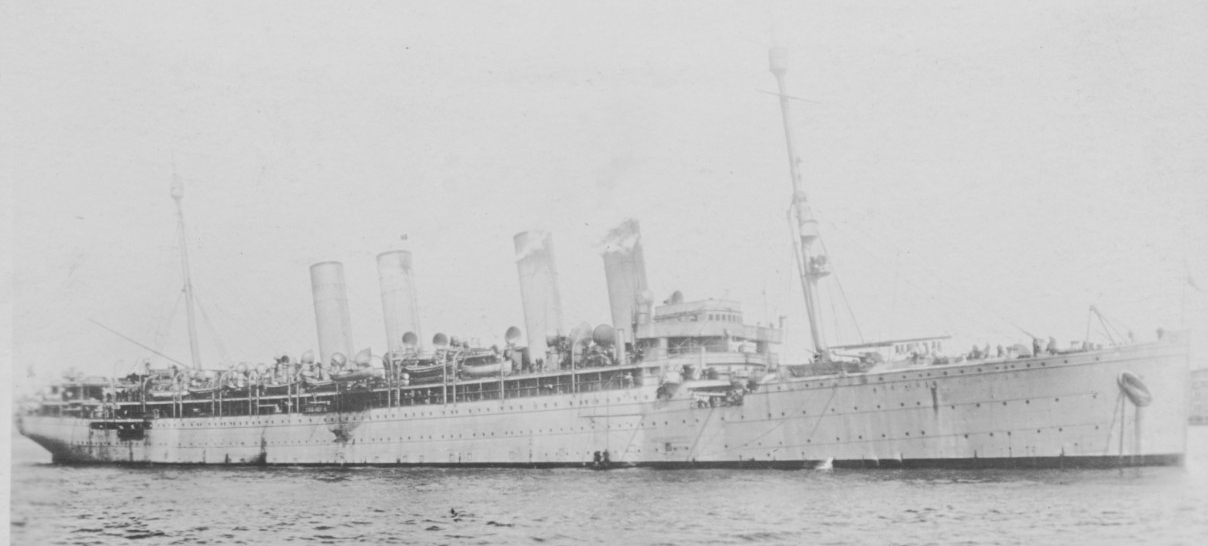
Von Steuben departed Philadelphia on 29 March 1918 and rendezvoused with Mount Vernon and U.S. Army Transport (USAT) Northern Pacific en route. The three ships were designated Special Group No. 2. After an uneventful passage, in which they rendezvoused with Wadsworth (Destroyer No. 60) [flagship], Macdonough (Destroyer No. 9), Reid (Destroyer No. 21), Drayton (Destroyer No. 23), Nicholson (Destroyer No. 52), Jarvis (Destroyer No. 38), and Preston (Destroyer No. 19) on 5 April, the convoy arrived at Brest on 7 April. Von Steuben then disembarked her 1,129 troops and passengers and unloaded cargo. Departing five days later on 12 April, she arrived at Hoboken, N.J. on 20 April. Von Steuben, with 1,141 troops and passengers on board, stood out from New York, in company with Northern Pacific as Group No. 31. En route they were met by Warrington Destroyer No. 30), Nicholson, Wadsworth, Monaghan, Preston, Jarvis, and Worden (Destroyer No. 16) and conveyed in to Brest on 4 May, where Von Steuben discharged her passengers and cargo. On 7 May, the transport anchored outside the Brest breakwater and then departed later that day bound for New York. The outbound escort parted company at 7:00 p.m. and Von Steuben continued in to New York, where she arrived on 15 May. She entered the New York Navy Yard, Brooklyn, N.Y., to undergo repairs and alterations to enable her to carry additional troops (16-16 May).
Von Steuben, having embarked 2,034 men, anchored off Fort Wadsworth, Brooklyn, N.Y., on 26 May 1918, awaiting her departure in another convoy. The next day, 27 May, she was underway steaming eastward as part of Group No. 39 in company with Henderson (Troop Transport No. 1), Henry R. Mallory (Id. No. 1280), and the British steamer Ulua. They later joined Siboney (Id. No. 2999) [convoy flagship], Mongolia (Id. No. 1615), Tenadores, Mercury (Id. No. 3012), and the Italian steamer American while en route. Von Steuben stood in to Brest on 9 June.
Escorted by Jarvis and Smith (Destroyer No. 17), Von Steuben cleared Brest on 11 June 1918 in company with American and Huron (Id. No. 1408). At 12:30 p.m. on 18 June, one of her lookouts reported wreckage ahead. As she steamed closer, seven small boats under sail came into sight on the port bow about five miles away. These men were the survivors of the British passenger steamer Dwinsk torpedoed earlier that day by U-151 (Korvettenkapitän Heinrich von Nostitz und Jänckendorff commanding). Von Steuben began a zigzag approach to pick up what appeared to be boatloads of survivors from a sunken Allied ship. About 20 minutes later, her lookouts reported the wake of a torpedo approaching her bow from abaft the port beam. The gun crews manned their stations and began firing at the torpedo while the commanding officer ordered the wheel hard to starboard and all engines full astern in an effort to avoid the missile. Meanwhile, some of the gunners had shifted their attention to what they thought to be the periscope of U-151, the submarine that fired the torpedo bearing down upon Von Steuben. The ship's efforts to slow down and turn away from the torpedo were successful. It passed a few yards ahead of the ship, and Von Steuben delivered a depth charge barrage which subjected the submarine to a severe shaking.
The real losers in that brief, but sharp, exchange were the survivors of the British steamer adrift in those seven small boats. U-151 had sunk their ship and remained in the area to use them as bait for other Allied ships. The possibility that they were simply decoys and that other submarines might be lurking about forced the ship to continue on without further investigation. That decision was further reinforced by the fact that the boats appeared empty. Credit for this must go to Capt. Henry Nelson, Dwinsk's master, who ordered his people to lie low in their craft so that other Allied ships would not be drawn into the waiting U-boat's trap. While Nelson and six lifeboats of his men were saved eventually, but the men in the seventh lifeboat were never rescued. Von Steuben arrived in New York on 20 June and began preparations for another voyage to France.
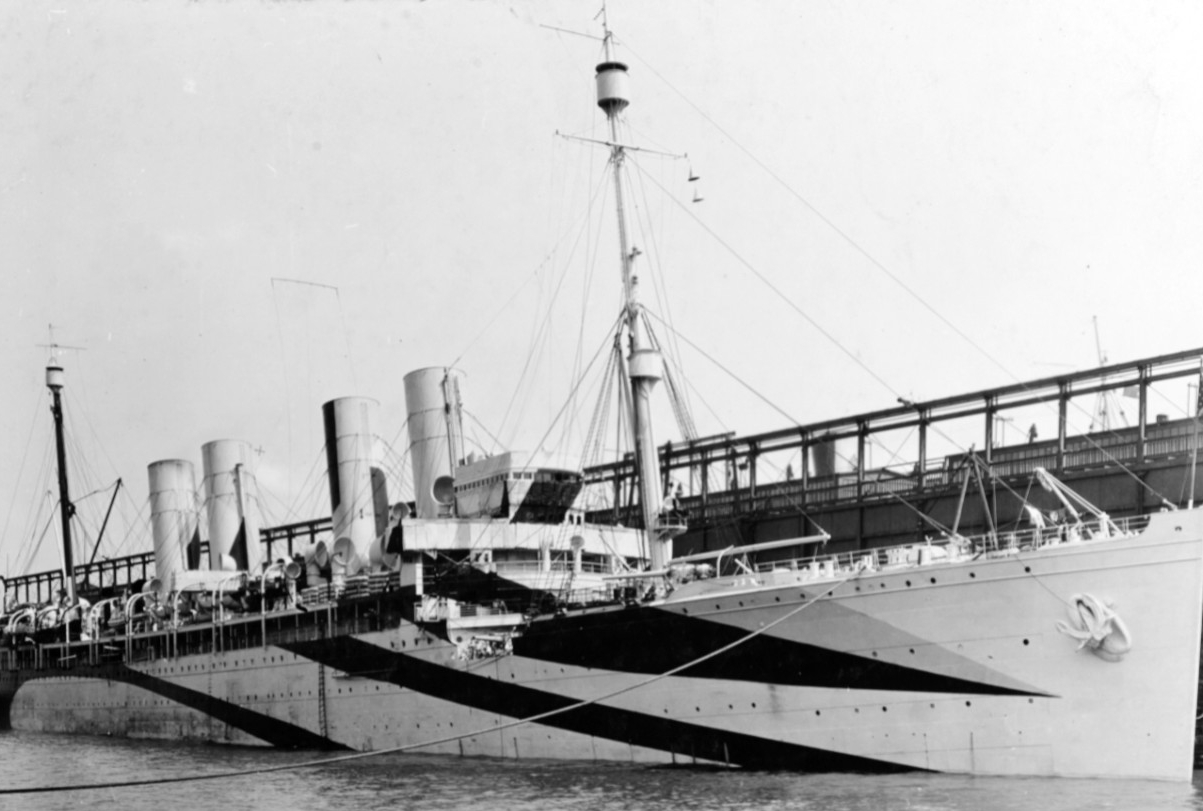
Von Steuben embarked troops for passage to Europe on 29 June; and the next day stood out of New York harbor and formed up with a convoy, Group No. 46, for the Atlantic crossing. The convoy consisted of Von Steuben [flagship], Siboney, Mongolia, President Grant (Id. No. 3014), Calamares (Id. No. 3662), Henderson, and the Italian steamer Duca Degli Abruzzi. They were joined en route by the Italian steamer America, Madawaska (Id. No. 3011), Huron, Henry R. Mallory, Tenadores, Zeelandia (Id. No. 2507), and the British steamer Kursk. They were being escorted by Frederick (Armored Cruiser No. 8), Seattle (Armored Cruiser No. 11), Colhoun (Destroyer No. 85) and Rathburne (Destroyer No. 113). At about noon on the third day out, 2 July, a fire broke out in the forward cargo hold of Henderson. As the blaze grew in intensity, the transfer of the Marine Corps’ 2nd Casual Replacement Battalion embarked became a necessity; and Von Steuben approached the burning ship. Working throughout the night, she had succeeded in embarking Henderson's more than 2,000 troops by morning. Henderson came about and made it safely back to the United States, while Von Steuben completed a somewhat cramped voyage at Brest on 9 July. Three days later, she cleared Brest and headed back across the Atlantic with civilians and wounded soldiers returning to the U.S. after service in Europe. After an uneventful passage, the transport reached New York on 21 July. She was then laid up for minor repairs until 18 August.
Von Steuben resumed duty transporting troops to Europe on 18 August 1918. Departing New York in company with George Washington (Id. No. 3018) and America (Id. No. 2181) as Group No. 57, all three arrived at Brest on 27 August without incident. Three days later, she stood out of Brest to make her return to the U.S. While en route alone on 6 September, the transport encountered a hurricane during which three of her crew were washed overboard and lost. She continued on and arrived at New York on the 7th. A week later, Secretary of the Navy Josephus Daniels and Rear Adm. Albert Gleaves, Commander, Cruiser and Transport Force, visited the ship and complimented her crew. The next day with the 13th Regiment of Marines embarked, she cleared New York with Matsonia (Id. No. 1589) and Louisville (Id. No. 1644) as Group No. 64. Murray (Destroyer No. 97) provided the escort. The ship arrived at Brest on 24 September. While underway on this eighth transit to France, however, the ship was stricken by an outbreak of Spanish influenza which resulted in 400 stretcher cases and 34 deaths. All but one of the deaths were marines. A week later, on 1 October, she stood out from Brest, bound for New York with Army, Navy, and civilian passengers. Also on board were the remains of the 33 men who died during the passage to France. The ship arrived and anchored in the harbor at New York on 10 October. Six days later, she stood out from New York on her ninth voyage to France. She steamed in Group No. 75, in company with Agamemnon and the Italian steamer America. After an uneventful passage, she reached Brest on 25 October and discharged her 1,592 troops and passengers. She then coaled and took on passengers, including wounded (27-31 October) and then cleared the French port on 1 November. Von Steuben returned to New York from her ninth wartime voyage on 8 November 1918, anchoring off the Statue of Liberty. She debarked her passengers the following day. In her nine eastward transatlantic passages, the transport carried 17,391 troops and passengers. Von Steuben entered the yard at the Morse Dry Dock & Repair Co., Brooklyn, N.Y., on 10 November. The next day, Germany signed the Armistice ending hostilities. The former German commerce raider remained in the yard through the new year and into March 1919.
Von Steuben, with her repairs and alterations finally completed on 2 March 1919, departed New York that same day. Bound for Brest, she steamed eastward in order to embark units from the AEF and bring them home. Arriving on 10 March, she embarked 2,806 troops and cleared Brest on 15 March. She arrived at Hoboken on 23 March and disembarked her first contingent of homeward bound troops.
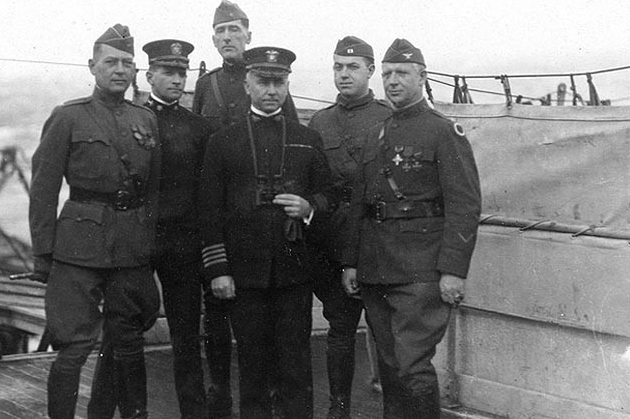
A week later, 30 March 1919, Von Steuben again steamed into the Atlantic on a course to France. Arriving at Brest on 7 April, she embarked 2,925 troops and conveyed them to Hoboken (19 April) for disembarkation. She made her third such shuttle, departing Hoboken on 24 April and arriving at Brest on 2 May. With 2,961 troops on board, she stood out on 5 May and made her return to Hoboken on 13 May. Underway again after five days [18 May], she made her fourth run to Brest, arriving on 26 May; embarked 2,842 troops, departed on 29 May, and stood in to New York on 6 June. Having crossed the Hudson, she cleared Hoboken on 11 June for another return to Brest. Arriving on 19 June, she took 2,968 troops on board and departed on 22 June. She tied up to the pier at New York on 30 June and disembarked her passengers. After a period of maintenance, Von Steuben was again underway on 11 July. Standing in to Brest on 19 July, she stood out on 21 July with 2,968 troops on board. Transiting westward across the Atlantic, she steamed through the Ambrose Channel and docked at New York on the 29th.
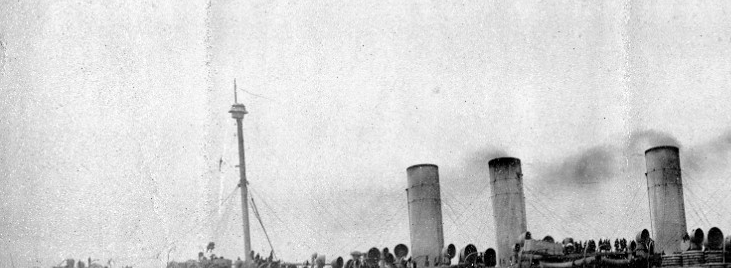
Von Steuben, having shifted to Hoboken, singled up lines on 4 August 1919, and made turns for France. Arriving at Brest on the 12th, she embarked 2,208 troops and departed on 24 August, making her return to New York on 1 September. Again crossing to Hoboken before departure for France, Von Steuben steamed down the Hudson on 10 September to initiate her final visit to Brest as a troop transport. Arriving on 19 September, she embarked 2,396 troops and cleared the French port on 21 September. Having steamed westward across the Atlantic, she steamed through the Verrazano Narrows and stood pierside at New York on 28 September. With this passage her service as a troop transport was completed. In the months since the Armistice, the ship had made eight voyages to Brest and back again and in so doing brought 22,047 AEF troops back to the U.S.
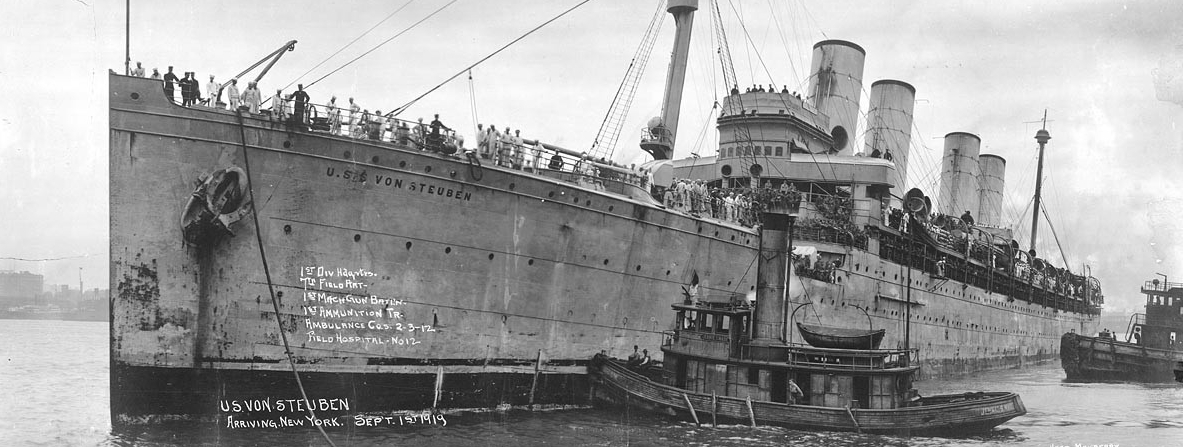
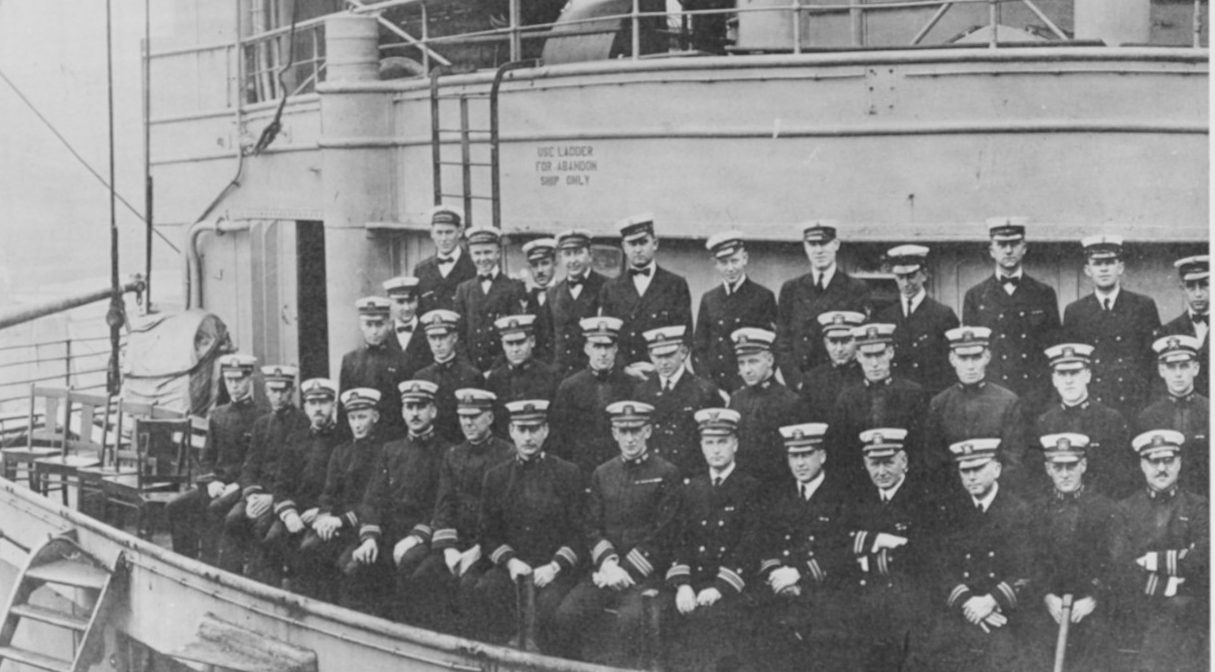
Von Steuben served the Navy until 13 October 1919 when she was decommissioned and turned over to the Army Transport Service. Her name was stricken from the Navy list on 14 October 1919; but, for almost five years, the ship continued to serve the United States under the auspices of the U.S. Shipping Board, first as Baron Von Steuben and, after 1921, simply as Von Steuben. The ship was sold to Boston Metal Co. on 7 March 1924 for dismantling and scrapping.
| Commanding Officers | Dates of Command |
| Lt. Charles H. Bullock | 9 June 1917 – 19 July 1917 |
| Cmdr. Stanford E. Moses | 19 July 1917 – 20 December 1917 |
| Capt. Yates Stirling, Jr. | 20 December 1917 – 9 September 1918 |
| Cmdr. Cyrus R. Miller | 9 September 1918 – 17 May 1919 |
| Cmdr. Frederick J. Horne | 17 May 1919 – 13 October 1919 |
Raymond A. Mann and amended by Christopher B. Havern Sr.
5 May 2018


